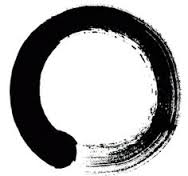densho (Japanese): large bell used to announce services and lectures.
doan (Japanese): Soto Zen term for one who rings bells in the zendo.
dojo (Japanese): Zen training center; one’s own place of enlightenment.
dokusan (Japanese): sanzen; to go or work alone; personal interview with the sensei or roshi.
doshi (Japanese): In Soto Zen, the doshi is an ordained person who leads the service by offering incense and leading prostrations and bows.
fukudo (Japanese): In Soto Zen, this is the person who strikes the han (see definition of han). During sesshins (retreats) the Fukudo, also rings the large bell in the foyer to summon participants to the zendo.
gassho (Japanese): anjali; hands palm to palm in a spirit of respect or devotion.
han (Japanese): In Zen monasteries, a wooden board that is struck with a mallet announcing sunrise, sunset and the end of the day.
Ino (Japanese): In Soto Zen, the Ino is in charge of the zendo (meditation hall). As well, the Ino is one of the four or five main leaders of a sesshin.
Jiko (Japanese): The timekeeper for a sesshin or for any meditation gathering.
“Katsu!” (Japanese): “Ho!” the shout given by Zen masters that wipes away everything.
Jisha (Japanese): In Soto Zen, the Jisha is the attendant to the Doshi during service.
kinhin (Japanese): sutra walk; the formal group walk between periods of zazen.
koan (Japanese): zen paradox, question or episode from the past that defies logical explanation.
Kokyo (Japanese): the Soto Zen term for the person who leads chanting during service.
kyosaku (Japanese): wake-up stick or encouragement stick.
mondo (Japanese): question and answer; Zen dialogue, usually between teacher and student.
nen (Japanese): thought; one thought frame.
okesa (Japanese): large patched robe made like Buddha’s robe, worn by priests.
oryoki (Japanese): a meditative form of eating that originated in Japan that emphasizes mindfulness. awareness practice by abiding to a strict order of precise movements
rakusu (Japanese): small patched neck robe made like Buddha’s robe, worn by people who have received precepts in an ordination.
raihai (Japanese): deep bows or prostrations.
Rinzai (Japanese): one of the two main schools of zen, traced from Lin-chi, ninth century, the other being Soto.
Rohatsu (Japanese): the day Japanese Buddhists observe the enlightenment of the historical Buddha, celebrated on December 8.
samu (Japanese): work service (in the sense of sutra service); meditation in work, traditionally in and about the temple.
Sensei (Japanese): A recognized teacher of zen. The title sensei, like the title roshi, traditionally is positioned after the teacher’s name rather than before (i.e. Jane Smith Sensei).
Soto (Japanese): the Soto Zen Buddhist Sect, traced from Tung-shan Liang-chieh, ninth century.
Shashou (Japanese): The position in which to hold the hands for kinhin and whenever moving about in the zendo. To form this position, first one hand should gently be made into a loose fist with the thumb held inside. The other hand is then wrapped around the fist with the thumb resting in the slight indendation at the top of the first hand. Together the hands are held at the upper part of the stomach area, near the base of the ribs.
Shika (Japanese): guest manager at the temple.
Shoten (Japanese): person who sounds the densho to announce events in the Buddha Hall.
Shuso (Japanese): head student for a practice period.
Soji (Japanese): brief period of mindful work; temple cleaning.
Soto (Japanese): One of the two main schools of zen in Japan, the other being Rinzai.
takuhatsu (Japanese): to show the bowl; to show the way of the Buddha; the walk taken by monks or nuns through towns near the temple to accept money or rice as contribution.
Tan (Japanese): raised platform for sitting in the zendo.
